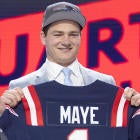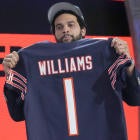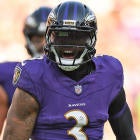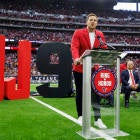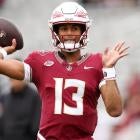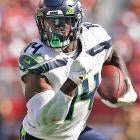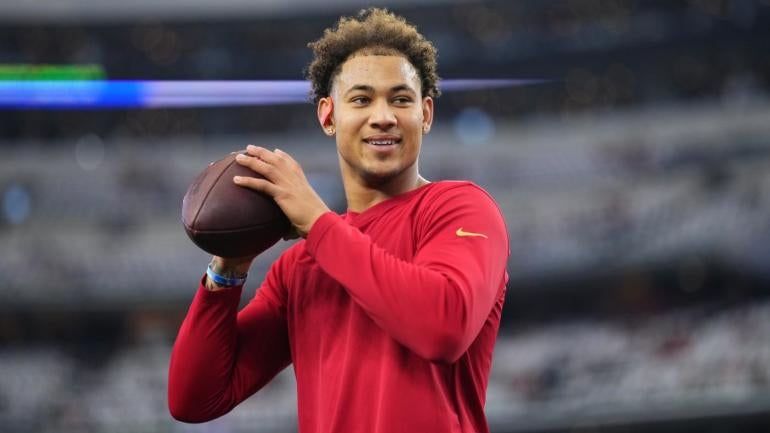
The Dallas Cowboys pulled off a shocker Friday night, acquiring former No. 3 overall pick Trey Lance from the San Francisco 49ers in exchange for a future fourth-round pick. The third-year quarterback was recently surpassed on the Niners' depth chart by fellow former No. 3 overall pick Sam Darnold, and now heads to Dallas to likely compete for the backup role behind Dak Prescott.
The Cowboys were surely not at or near the top of the list of teams most thought would be involved in the Lance sweepstakes, so their landing him comes as quite the surprise. Why, then, would they make a move like this? Let's walk through a few potential reasons it makes sense -- even for a team with a locked-in starter whose contract includes a no-trade clause.
1. Dallas has been looking for another QB
Way back at the Senior Bowl, Jerry Jones told reporters that the Cowboys were "committed" to selecting a quarterback in the 2023 draft, and that they should have been committed to selecting one the year before. But when the draft came around, things didn't break right for the Cowboys.
Once each of the top five quarterbacks came off the board, none went until Jake Haener and Stetson Bennett were taken with back-to-back late fourth-round picks. The Cowboys had the very next selection, which they used on defensive lineman Viliami Fehoko. In between that selection and their next pick, cornerback Eric Scott, five more quarterbacks (Aidan O'Connell, Clayton Tune, Dorian Thompson-Robinson, Sean Clifford, and Jaren Hall) came off the board. So, the Boys left the draft without another quarterback, even though they wanted to take one.
In trading a future fourth-round pick for Lance, they essentially landed a player with a pick in the same range that those seven players were selected -- except the player they landed was talented enough to be selected No. 3 overall two years ago and is still just 23 years old. (He's actually younger than each and every one of Haener, Bennett, O'Connell, Tune, Thompson-Robinson, Clifford, and Hall.)
Lance has two years remaining on his rookie deal, with cap hits of $940,000 in 2023 and $5,310,717 in 2024. That's plenty affordable for a backup quarterback. And if it doesn't work out with Lance beyond that, all they gave up was a fourth-rounder. As noted above, teams use picks in that range on players they intend to be backup quarterbacks all the time.
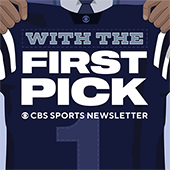
With The First Pick Newsletter
With The First Pick Newsletter
Prepare for the upcoming NFL Draft with the day’s big stories + mock drafts, big board updates and more.
Thanks for signing up!
Keep an eye on your inbox.
Sorry!
There was an error processing your subscription.
2. Lance has significantly more upside than the current backups
Dallas' incumbent backup quarterback is Cooper Rush. He has posted a 5-1 record as a starter when filling in for Prescott over the past two seasons, but deeper examinations reveal his play to have been quite flawed. (Among the 39 quarterbacks who threw at least 150 passes last season, Rush ranked 33rd in off-target throw rate, according to Tru Media, ahead of only Zach Wilson, Marcus Mariota, Justin Fields, Taylor Heinicke, Baker Mayfield, and Davis Mills. He was dead last among the same group of players in third-down conversion rate.) And he is a soon-to-be 30-year-old career backup with little upside to speak of. (The No. 3 QB throughout this offseason has been Will Grier, who has been unable to beat out Rush for the backup job in consecutive training camps.)
Lance is on the opposite end of the spectrum. Over the past several years, the league has been taken over by quarterbacks who are -- for lack of a better term -- physical freaks. Players like Patrick Mahomes, Josh Allen, and more are monster-sized, with monster arms, and mobility to boot. The reason the Niners identified Lance as the guy to move up for in the 2021 NFL Draft is because they thought he could fit that mold. At 6-foot-4 and 224 pounds, he has the size. Lance didn't participate in the NFL Scouting Combine, but he ran for 1,000 yards in his lone full season as a starter in college. Even in his rare NFL appearances, he ran a whole lot, and for a bunch of yardage. He has the mobility aspect. He also has crazy arm strength, and the willingness to fire the ball down the field and/or into tight windows in an effort to make big plays.
Where Lance has struggled to date is with injuries, accuracy, and processing. The injuries, the Cowboys can't do much about. But pairing Lance with Prescott will give him a partner who can help with processing and reading defenses. Prescott is considered one of the league's best pre-snap operators, and before last season's strange turnover surge, he had generally shown excellent accuracy and ball placement throughout his career. (He ranked 10th, 11th, 6th, 6th, and 6th in NFL.com's NextGen Stats' completion percentage over expectation from 2017 through 2021 before finishing tied for 12th last year.)
3. Lance has immediate utility as a weapon in the run game
Early in his career, Prescott was a very dangerous threat as a runner. In each of his first three seasons, he rushed for exactly six touchdowns, and at least 21 first downs. He averaged 63 rushing attempts per season and averaged 5.0 yards per carry. Since breaking his ankle in 2020, however, Dak has rushed a combined 93 times for 328 yards (3.5 per attempt) and just two scores.
The Cowboys are both more reluctant to use him in the run game, and he is less effective than he once was. When you're paying a quarterback as much money as Dallas is, and when said quarterback suffered a potentially career-altering injury while scrambling, it makes sense to be a bit more conservative with your use of him as a runner.
Lance actually suffered a similar injury to Prescott last season, but a) Lance is seven years younger than Prescott; and b) the Cowboys don't have upwards of $40 million per year invested in Lance, so they are less likely to be concerned with him taking "extra" hits as a runner in short-yardage or goal-line situations. Having him as an additional threat can help offset the loss of Ezekiel Elliott, whose best skill last year was his ability to convert in short yardage. (It's the one area where he arguably out-performed Tony Pollard.)
4. Optionality
Six months ago, the Kansas City Chiefs defeated the Cowboys' division rivals, the Philadelphia Eagles, in the Super Bowl. In the wake of that game, we ran back our annual story on what NFL teams could learn from the two teams that played for the championship. This was the very first lesson we highlighted:
Don't settle for 'good enough' at QB
From 2013 through 2016, Alex Smith was actually pretty damn good. He went 41-20 during the regular season, completing 64.5% of his passes at an average of seven yards per attempt, with 76 touchdowns against just 28 interceptions. The Chiefs came in first or second in the AFC West in each of those four seasons, and made the playoffs in three of four years. They did not make it past the divisional round, though, and the Chiefs recognized that Smith was good, but not great.
So, in the 2017 NFL Draft, they aggressively moved up the board to draft Patrick Mahomes, hoping he could take their offense to new heights. Even after Smith had arguably his best season in 2017, the Chiefs moved on and gave Mahomes the reins under center. The rest is literally NFL history. In five seasons as the starter, he has two 5,000-yard passing seasons, two seasons leading the NFL in passing touchdowns, two regular-season MVPs, three All-Pro appearances (two first team), two Super Bowls, and two Super Bowl MVPs. Safe to say the Chiefs made the right move.
On the other side of the field, the Eagles are ALWAYS looking for more quarterback talent. Even after Carson Wentz had an MVP-caliber season in 2017, the Eagles still saw fit two seasons later to take a quarterback in the second round of the draft. Philadelphia was ridiculed in some circles for drafting Jalen Hurts, but general manager Howie Roseman believed that giving his team options in the pursuit of elite quarterback play was the best path. It turned out to be the right one. Wentz fell off hard, and Hurts this season was the MVP runner-up behind Mahomes. He was spectacular in the Super Bowl, just as he was throughout the regular season. Don't be surprised if, even if Philly signs Hurts to a contract extension befitting his level of performance, the Eagles continue stacking talent in the quarterback room.
Prescott has been pretty damn good throughout his career. He's completed 66.6% of his passes at an average of 7.6 yards per attempt. Among qualified quarterbacks all time, he ranks eighth in passer rating, ninth in adjusted net yards per attempt, and ninth in interception rate. The Cowboys have four double-digit win seasons with him under center, as many as they'd had in the previous 13 seasons before he took over for Romo. He's also won a couple of playoff games -- exactly as many as the team won from 1996 through the time he took over. He is, without question, good enough to have you in the mix.
But as we wrote six months ago, teams shouldn't just settle for good enough because it's there, and because it's comfortable. Giving yourself options at the most important position in football is just good business. Especially when they come at a low cost. That's what Dallas did here.
Back in 2016, the Cowboys used a fourth-round pick on a 23-year-old, toolsy quarterback with great size, speed, and agility, but who likely needed work with his accuracy and processing. The idea was for him to be a developmental backup behind the team's long-term starter, and if everything worked out, maybe he could become a starter himself one day. That "one day" happened much sooner than expected, as Tony Romo broke his back, Kellen Moore broke his foot and Dak Prescott stepped into the starting lineup and never looked back. Seven years later, it appears Dallas is trying to work the same strategy. If everything works out, great. If not, all it cost was another fourth-round pick.














